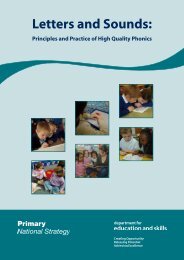What is the research evidence on writing? - Department for Education
What is the research evidence on writing? - Department for Education
What is the research evidence on writing? - Department for Education
Create successful ePaper yourself
Turn your PDF publications into a flip-book with our unique Google optimized e-Paper software.
Twenty eight per cent of pupils achieved level 5 or above, with girls outper<strong>for</strong>ming<br />
boys (35 per cent compared to 22 per cent). Writing was <str<strong>on</strong>g>the</str<strong>on</strong>g> element with <str<strong>on</strong>g>the</str<strong>on</strong>g><br />
lowest per<strong>for</strong>mance compared to reading, ma<str<strong>on</strong>g>the</str<strong>on</strong>g>matics and science (DfE, 2012b).<br />
Writing compared to reading<br />
As with Key Stage 1, additi<strong>on</strong>al internal DfE analys<str<strong>on</strong>g>is</str<strong>on</strong>g> compared <str<strong>on</strong>g>the</str<strong>on</strong>g> 2011 Key Stage 2<br />
reading and <strong>writing</strong> levels of pupils. Overall, <str<strong>on</strong>g>the</str<strong>on</strong>g> same pattern that we saw in Key<br />
Stage 1 <str<strong>on</strong>g>is</str<strong>on</strong>g> repeated at Key Stage 2.<br />
The table below shows <str<strong>on</strong>g>the</str<strong>on</strong>g> breakdown of levels achieved by pupils in Key Stage 2<br />
reading and <str<strong>on</strong>g>the</str<strong>on</strong>g>ir corresp<strong>on</strong>ding Key Stage 2 <strong>writing</strong> levels:<br />
Table 7<br />
100%<br />
90%<br />
80%<br />
70%<br />
60%<br />
50%<br />
40%<br />
30%<br />
20%<br />
10%<br />
0%<br />
KS2 Reading Levels by KS2 Writing Levels<br />
A B N 3 4 5<br />
KS2 Engl<str<strong>on</strong>g>is</str<strong>on</strong>g>h Reading Level<br />
Source: DfE internal analys<str<strong>on</strong>g>is</str<strong>on</strong>g> using NPD, 2011<br />
KS2 Engl<str<strong>on</strong>g>is</str<strong>on</strong>g>h Writing Level A<br />
KS2 Engl<str<strong>on</strong>g>is</str<strong>on</strong>g>h Writing Level B<br />
KS2 Engl<str<strong>on</strong>g>is</str<strong>on</strong>g>h Writing Level N<br />
KS2 Engl<str<strong>on</strong>g>is</str<strong>on</strong>g>h Writing Level 3<br />
KS2 Engl<str<strong>on</strong>g>is</str<strong>on</strong>g>h Writing Level 4<br />
KS2 Engl<str<strong>on</strong>g>is</str<strong>on</strong>g>h Writing Level 5<br />
Pupils achieving level B (working below <str<strong>on</strong>g>the</str<strong>on</strong>g> level assessed by <str<strong>on</strong>g>the</str<strong>on</strong>g> tests) are reported<br />
in th<str<strong>on</strong>g>is</str<strong>on</strong>g> way in both reading and <strong>writing</strong>. For pupils who are achieving an A (absent) or<br />
N (no test level awarded) <str<strong>on</strong>g>the</str<strong>on</strong>g>re <str<strong>on</strong>g>is</str<strong>on</strong>g> a spread of results that <str<strong>on</strong>g>the</str<strong>on</strong>g>y achieve in <strong>writing</strong>.<br />
There <str<strong>on</strong>g>is</str<strong>on</strong>g> also a spread of results from pupils achieving level 3 and above in reading<br />
levels compared to <strong>writing</strong> results. For example, out of <str<strong>on</strong>g>the</str<strong>on</strong>g> pupils achieving a level 4<br />
(<str<strong>on</strong>g>the</str<strong>on</strong>g> expected level) in reading, 68 per cent achieve <str<strong>on</strong>g>the</str<strong>on</strong>g> same level in <strong>writing</strong>, with 25<br />
per cent achieving a level 3, and 6 per cent achieving level 5 in <strong>writing</strong>. Of pupils<br />
achieving level 5 in reading, 60 per cent achieved a lower level in <strong>writing</strong>.<br />
Regarding <str<strong>on</strong>g>the</str<strong>on</strong>g> achievement of certain groups of pupils, fewer boys than girls are<br />
likely to per<strong>for</strong>m as well in <strong>writing</strong> as <str<strong>on</strong>g>the</str<strong>on</strong>g>y do in reading. Pupils who have a SEN and<br />
pupils eligible <strong>for</strong> FSM are less likely to per<strong>for</strong>m as well in <strong>writing</strong> as <str<strong>on</strong>g>the</str<strong>on</strong>g>y do in<br />
reading compared to n<strong>on</strong> SEN pupils and n<strong>on</strong> FSM pupils respectively.<br />
Children whose first language was ‘o<str<strong>on</strong>g>the</str<strong>on</strong>g>r than Engl<str<strong>on</strong>g>is</str<strong>on</strong>g>h’ are slightly more likely to<br />
per<strong>for</strong>m as well in <strong>writing</strong> as <str<strong>on</strong>g>the</str<strong>on</strong>g>y do in reading compared to children whose first<br />
37
















